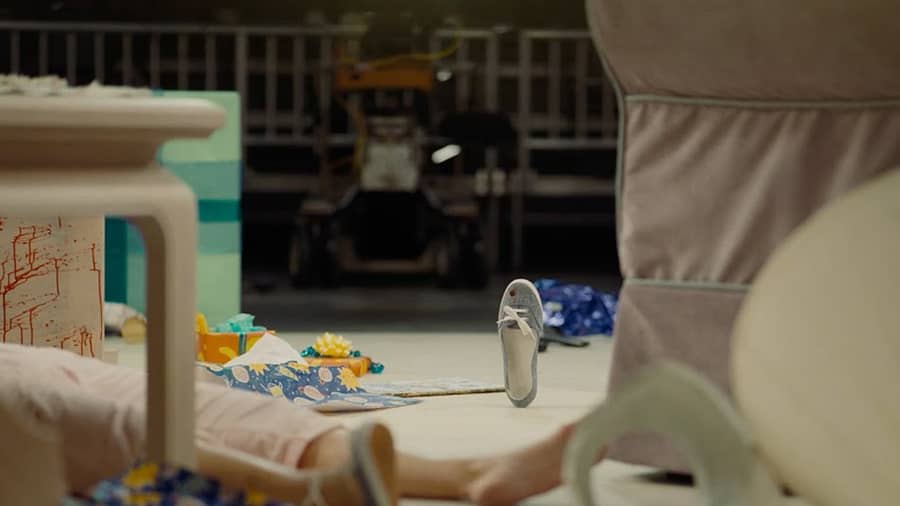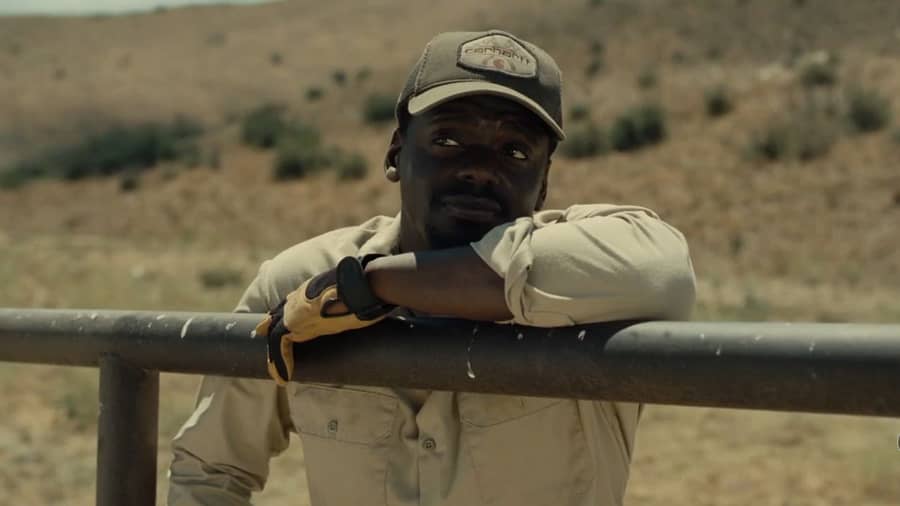Nope, directed by Jordan Peele, starts with a horrific scene that’s only fully shown later in the film and isn’t connected to the primary plot. The year is 1998 and Gordy, a trained chimpanzee that was the star of a fan favorite sitcom, loses control on the set of the show. During the filming of Gordy’s birthday, the balloons used in the scene rise up and start popping. Mistaking it to be a threat, Gordy attacks everyone on set — at least everyone that tries to tame him. The attack results in the live audience running away for their safety, a child star’s face getting disfigured and the two adult stars getting killed.
The other child star, the younger Jupe, who’s the only Asian character in a family otherwise Caucasian, hides under the table and witnesses the attack. What’s more unsettling about what he sees, however, isn’t just the attack but a single shoe standing upright in the middle of the set. Jupe’s eyes stay fixed on that.
Once Gordy is done killing everyone and feeling safe, he notices Jupe under the table, scared. Their eyes don’t necessarily meet as Jupe only sees Gordy through a translucent table cloth. Gordy approaches Jupe and reaches for a fist bump instead — something their characters in the show used to do frequently — but gets shot by the police who’ve just arrived at the scene. A young Jupe is covered in Gordy’s blood.
Cut to the present. Jupe — or Ricky Park, his official name, played by the charismatic Steven Yuen — now owns an amusement park, Jupiter’s Claim, in a deserted section of California. In the park, by his office, is a museum of sorts where he exhibits things from the night of the tragic incident, including the standing shoe, which is still kept in a similar fashion. Jupe charges people to see this, and charges even more to spend a night there. He has found a way to profit off his own tragedy.

The case of the ‘bad miracle’
The subplot in a way prepares us for what’s about to come. OJ (played by Daniel Kaluuya) asks his sister Em (played by Keke Palmer) what a ‘bad miracle’ is called. He has seen two now. First was six months ago when his father, Otis, died after a coin fell from the sky and struck his eye. The second is a recent one — OJ has just seen what looked like a flying saucer, an UFO. It’s a spectacle that’s logically impossible. And this is why the siblings decide to cash in on it, trying to record footage of the UFO and break it to Oprah. Yes, the Oprah. Fame and money are the top-most aspirations in their minds when talking about ‘bad miracles’. It might seem strange, however, they aren’t the only ones chasing this.
This is where Nope’s theme really solidifies. We’re driven to get everything on film; record everything and use those to our advantage or our entertainment. OJ and Em want to record the ‘impossible shot, the Oprah shot’, the shot that would take them out of their miseries. They want to record and exploit it without even properly understanding what it is they are filming.
Similarly, the makers of Gordy’s Home, the show that had used Gordy a little over two decades back, used a chimpanzee without taking into account the risks associated with it. A chimpanzee is a wild animal and it’s foolish to expect them to live by our rules and expectations, without them reacting aggressively if they find anything that could be a threat. Humans, since the dawn of documentation, have always wanted to document ‘the impossible’. Documentation legitimises their beliefs and makes the ‘impossible’ possible. What the pioneer TV industry professionals did by introducing the wild on your television screen was no different. For there was a time, when seeing a chimpanzee live happily with a white Caucasian family on your television screen was a ‘spectacle’ and something that you wouldn’t see easily. The popularity of the show grew and so did the need for exploitation of the chimp for their own amusement.
Profiting from the wild
OJ’s object of fascination isn’t very different. The UFO turns out to be an alien creature living behind the clouds that hunts the living — animals and humans alike. Gordy and Jean Jacket — the name OJ gives to the UFO-like alien — are both wild animals. They’ve their own set of rules and as humans we must follow them if we want to avoid confrontations, instead of finding ways to manipulate them for our interests. This is a lesson that despite surviving the tragedy, Jupe doesn’t learn. Instead, he carries the wrong lesson with him growing up.
The young Jupe was spared because he did not look eye to eye with a predator. He wasn’t threatening and during the rampage, Jupe was just scared — he didn’t try to control or manipulate Gordy. That coupled with the impossible nature of a shoe standing upright in the middle of the massacre made Jupe believe that he was ‘chosen’.
In the present day, when Jupe finds out about Jean Jacket, he doesn’t alert the town residents or the neighbors — OJ and Em. Instead he turns it into a performative show by sacrificing horses for the alien predator in front of a live audience. In his mind, he has a special bond with the wild, a deal done between the two that is otherwise impossible for others to achieve. But that thought is short-lived. A special performance doesn’t go as planned and the alien creature — that Jupe expected to dance to his tune — instead ends up eating him along with the rest of the audience and staff members. Jupe tried to exploit the wild again and profit from an unexplained phenomenon. Sadly, and two decades apart, the results weren’t very different.
An impossible spectacle
There’s no clear indication as to what the standing shoe implies. Jupe exploited his own tragedy and turned it into a profitable spectacle. Which perhaps ties to the theme of the larger plot of the film. OJ and Em, despite knowing the consequences of their actions and already having survived an alien attack, are insistent on cashing in on it. Angel, the tech salesman and their companion in the mission, was the first to actually question — is the agenda to record the spectacle bringing any good to the world? Are people’s lives going to change? Nobody asks that question after that moment.
Instead people are obsessed with their own hunt for fame and greatness. The siblings want to go to Oprah. Holst, a renowned cinematographer, wants to capture Jean Jacket in the golden hour as he aims for greatness. A TMZ reporter wants to break the news at any cost without understanding the situation at hand. Nope taps into our obsession with getting it recorded, getting it documented without understanding the full picture. Which is perhaps why the ambiguity surrounding the implication of the standing shoe adds to the film.
The most beautiful moment in the film, however, is after Em manages to capture the shot she was looking for — Jean Jacket in the sky — in the climatic scene that takes place in Jupiter’s Claim, the now empty amusement park. She turns towards the park gate and finds her brother, OJ, sitting on a horse behind veils of dust. She had, for sometime, thought that he had sacrificed his life to save her. But here he is, like an ‘impossible’ spectacle, a miracle . It’s unclear if he’s actually alive or if it is just Em imagining him. Em believes that he’s there in front of her. And that is what matters.











